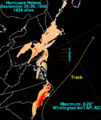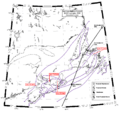Hurricane Helene (1958) facts for kids
| Category 4 major hurricane (SSHWS/NWS) | |

Radar image of Hurricane Helene on September 27, 1958
|
|
| Formed | September 21, 1958 |
|---|---|
| Dissipated | September 29, 1958 |
| Highest winds | 1-minute sustained: 150 mph (240 km/h) |
| Lowest pressure | 930 mbar (hPa); 27.46 inHg |
| Fatalities | 0 direct, 1 indirect |
| Damage | $11.4 million (1958 USD) |
| Areas affected | United States East Coast, Atlantic Canada, British Isles |
| Part of the 1958 Atlantic hurricane season | |
Hurricane Helene was a very strong tropical cyclone that formed in 1958. It was one of the most powerful Atlantic storms of that year. At its strongest, Helene had winds of about 135 miles per hour (217 km/h). This powerful hurricane moved north of the West Indies and then brushed past the United States' east coast. Helene was the only hurricane to affect the United States in 1958.
Contents
How Hurricane Helene Formed
Hurricane Helene began as a tropical depression on September 21, 1958. It formed near the Cape Verde islands in the eastern Atlantic Ocean. A tropical depression is a storm system with organized thunderstorms and a low-pressure center. It is the first stage of a hurricane.
Growing into a Hurricane
As the system moved west, it quickly became stronger. By September 22, it had become a tropical storm. This means its winds were getting faster. On September 24, Helene officially became a hurricane. This happened when its winds reached at least 74 miles per hour (119 km/h).
Helene's Peak Strength
Helene continued to gain power as it moved across the Atlantic. On September 26, it reached its strongest point. It became a powerful Category 4 hurricane on the Saffir–Simpson hurricane wind scale. At this time, its winds were about 135 miles per hour (217 km/h). Its lowest pressure was 930 millibars. This is a very low pressure, which shows how strong the storm was.
Helene's Path and Impact
After reaching its peak strength, Hurricane Helene turned towards the northwest. It moved very close to the East Coast of the United States. Even though it did not make a direct landfall in the U.S., it caused a lot of problems.
Effects on the United States
Helene came very close to North Carolina and South Carolina. It brought strong winds and heavy rain to these states.
- In North Carolina, winds reached 100 miles per hour (160 km/h) in some places.
- Many trees were blown down, and power lines were damaged.
- Coastal areas experienced storm surge and beach erosion. This means the ocean water rose higher than normal, washing away parts of the beach.
- About 200,000 people had to leave their homes in North Carolina.
- The storm caused about $11.4 million in damages in 1958. This would be much more money today.
- Sadly, one person died indirectly because of the storm. This means their death was related to the hurricane, but not directly from its winds or water.
Moving Towards Canada
After passing the U.S. coast, Helene moved northeast. It weakened a bit but was still a strong storm. It then affected Atlantic Canada.
- Provinces like Nova Scotia and Newfoundland and Labrador felt the storm's effects.
- Helene brought heavy rain and strong winds to these areas.
- Some places received over 5 inches (127 mm) of rain.
- There were reports of power outages and some flooding.
Helene's Final Days
As Helene moved further north and east, it entered colder waters. This caused the hurricane to lose its tropical features. On September 29, 1958, Hurricane Helene changed into a non-tropical storm. It eventually moved towards the British Isles before finally disappearing.
Images for kids
See also
 In Spanish: Huracán Helene (1958) para niños
In Spanish: Huracán Helene (1958) para niños




